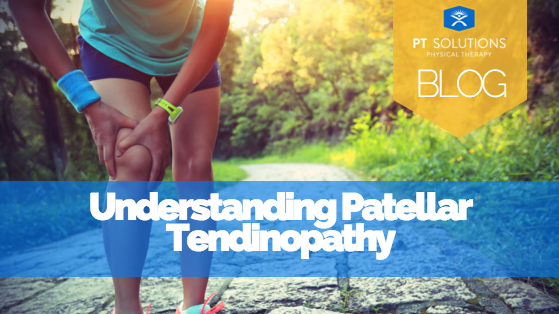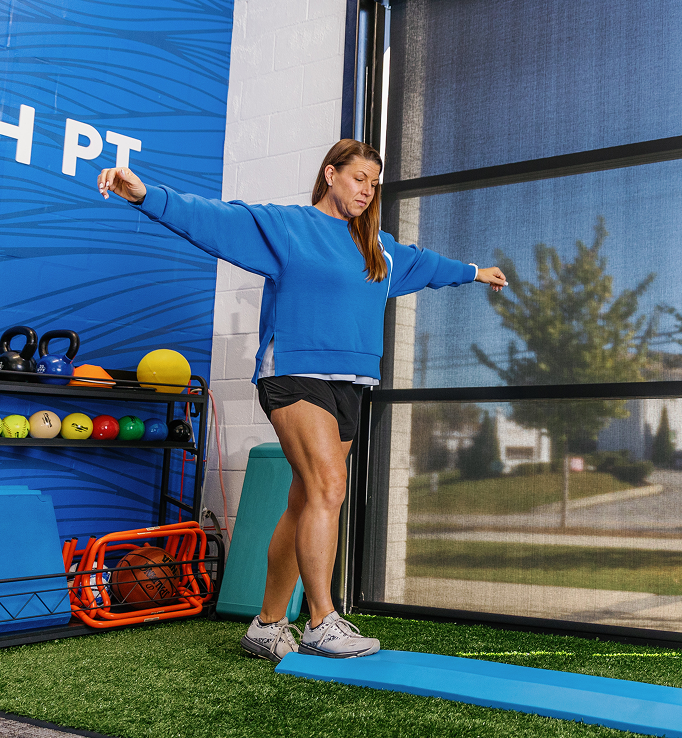Understanding Patellar Tendinopathy (Jumper’s Knee)

Knee pain doesn’t always start with one bad landing. Sometimes it builds quietly, rep after rep and jump after jump, until it hurts to run, climb, or even stand up. That’s the story behind patellar tendinopathy, or jumper’s knee.
This condition happens when the tendon connecting your kneecap to your shinbone becomes irritated or overloaded. It’s common in athletes who jump, sprint, or change direction often. Basketball, volleyball, and track athletes deal with it most. But it’s not limited to sports. Anyone training hard, skipping recovery, or spending long days on their feet can feel that familiar ache just below the kneecap.
What Causes Patellar Tendinopathy?
Patellar tendinopathy develops when small tendon fibers break down faster than they can be repaired. The main drivers are repetitive jumping, sprinting, or heavy lower-body loading. These types of high-impact activities increase tension where the kneecap meets the shin. Weak glutes, tight quads, or limited ankle mobility make the knee work even harder, compounding stress on the patellar tendon.
These same overload patterns often show up in sports-related injuries like sprains and strains or balance rehabilitation cases, where tissue recovery can’t keep pace with training demand. Over time, that imbalance turns a temporary irritation into a chronic condition.
Common Symptoms of Jumper’s Knee
Most people describe pain right below the kneecap that worsens during activities like jumping, squatting, or running. Early on, discomfort fades with rest. Later, it lingers into daily movement, making it tough to climb stairs or stand for long periods.

Typical signs include:
- Tenderness at the base of the kneecap
- Morning stiffness or pain after sitting
- Swelling around the tendon
- Weakness or instability when extending the knee
Ignoring symptoms or “training through it” often leads to a longer recovery process, especially when other conditions like knee pain or overuse injuries start to overlap
How Physical Therapy Helps
Pain medication may calm symptoms, but only physical therapy targets the source. Tendons respond best to progressive loading, following the right exercises, in the right order, at the right pace.
Treatment at PT Solutions often combines:
- Manual therapy to release tension in the quads and improve tissue mobility
- Eccentric and heavy-slow strengthening to rebuild tendon tolerance
- Functional retraining to improve jumping, squatting, and running mechanics
- Sport-specific loading to restore confidence and durability
These principles align with the approach used in sports physical therapy and athletic training, helping athletes and active adults return to pain-free movement safely and consistently.
Recovery Timeline and What to Expect
Healing timelines vary depending on how long symptoms have been present and how consistent the rehab is.
Typical recovery:
- Mild (Grade 1–2): 4–6 weeks of guided therapy and gradual loading
- Moderate to chronic (Grade 3): 8–12+ weeks for full tendon remodeling
In chronic cases, physicians may recommend adjunct treatments like injections, but long-term improvement still depends on progressive strength and proper movement retraining. The principles mirror those used for broader sports injuries and conditions where structure and pacing determine outcomes.
Prevention and Return to Sport
Prevention starts with smart training and recovery. Tendons tolerate load more effectively if they have enough time to adapt.
Key habits that protect the patellar tendon:
- Gradual training progressions (avoid sudden volume spikes)
- Strengthening hips, quads, and calves twice weekly
- Mobility work for the ankles and quads to improve knee mechanics
- Warm-ups that prime movement before high-impact training
- Scheduled recovery days between hard sessions
These same strategies support overall lower-body health and reduce the risk of other running-related issues like overuse or jumper’s knee flare-ups.
When to Seek Professional Care
If knee pain lasts beyond a couple of weeks or limits daily activity, a professional evaluation helps prevent chronic tendon changes. Persistent discomfort — especially with bending, jumping, or stairs — signals that the tendon needs structured loading, not rest alone.
At PT Solutions, licensed physical therapists specialize in orthopedic and sports injury rehabilitation, guiding recovery plans that match your movement goals and activity level.
How PT Solutions Treats Patellar Tendinopathy
At PT Solutions, treatment starts with understanding the “why” behind your knee pain — not just calming symptoms. Every plan is customized through a full movement assessment that looks at training load, mechanics, and recovery habits.

Your treatment may include:
- Targeted manual therapy to improve mobility in the hips, quads, and knees
- Progressive tendon loading using eccentric and heavy-slow exercises has proven to rebuild strength
- Neuromuscular retraining to correct jumping, landing, or running mechanics
- Balance and coordination work to reduce stress on the patellar tendon
- Return-to-sport programming guided by data-driven progression and functional testing
Each session focuses on helping you move with confidence again, whether that means returning to sport, training pain-free, or simply getting through your day without stiffness.
FAQs
Is jumper’s knee the same as patellar tendinitis?
Yes. Both describe irritation or degeneration of the patellar tendon (the band connecting your kneecap to your shinbone).
Can you keep running with patellar tendinopathy?
If pain is mild, improving, and doesn’t alter your stride, gradual running can fit within rehab. A therapist can help determine safe loading levels.
What’s the best exercise for patellar tendinopathy?
Decline squats and heavy-slow quad strengthening show the strongest results for rebuilding tendon capacity and relieving pain.